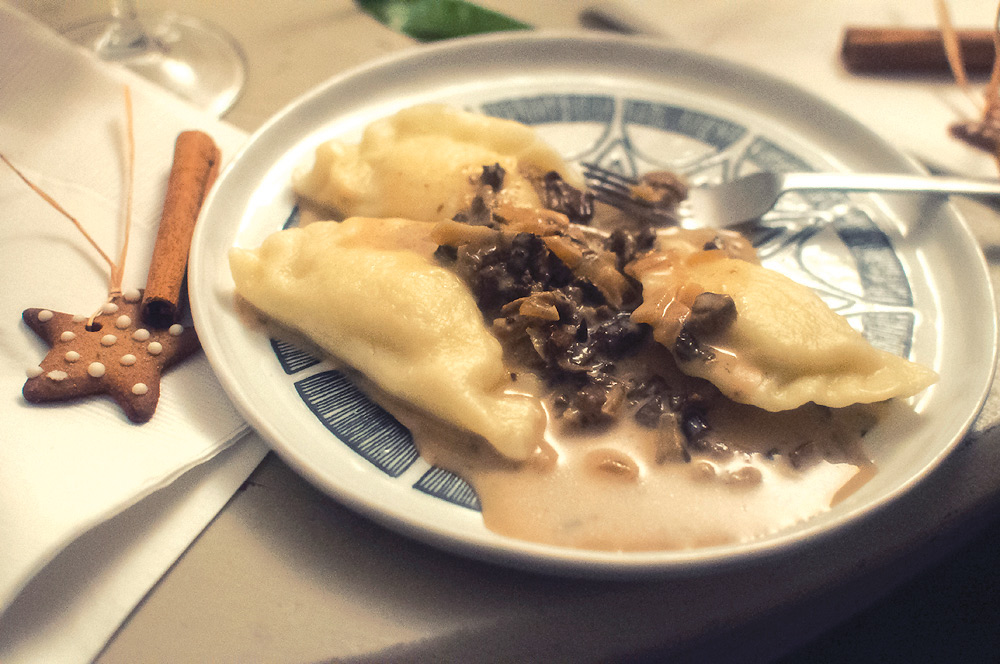Mixing the heartiness of German cooking with some of the more exotic elements of Russian and traditional Jewish deliciousness, Polish food is surprisingly inventive. Polish dishes developed over the years from what can actually be grown or raised in the country’s harsh, northern climate, and the food is almost always seasonal, local and sustainable.
Dumplings (Pierogi)
Thanks to their popularity among Poland’s long-standing immigrant population, pierogi are as closely associated with Polish cuisine as pizza is to Italian. These are tiny dough pockets, traditionally stuffed with cottage cheese, potato, cabbage, or ground meat, and prepared either boiled or fried.
Pierogi are naturally delicious, but the key to their popularity is versatility, both in terms of what to stuff them with — and when to eat them; they make a perfect between-meal snack or light lunch or dinner. They’re classic peasant fare, but also a staple (the meatless varieties, at least) at Christmas Eve dinners around Poland. As for the stuffing, well, these days, just about anything goes. In addition to the classics, we’ve seen fruit fillings, mushrooms, cheeses and even bison meat.
Potato Pancakes (Placki)
A comfort-food cousin to pierogi (and similar to Jewishlatke), Polish placki are nearly as well known and just as delicious. The key to the perfect potato pancake is in the grating, and the finer the better. The grated potatoes are usually mixed with flour and egg, and flavored with onion or garlic. They’re fried to a crispy brown in a shallow layer of oil over the stove, and eaten – as a snack or side – with a shake of salt and dollop of sour cream.
Sausage (Kiełbasa)
Kiełbasa is another Polish word that’s entered the English language through the stomach. Poland has an infinite variety of sausages, and it would take a month to try them all. Traditionally, kiełbasa is made from pork meat, often spiked with garlic and pepper (and spices like marjoram or caraway seed), though beef and veal varieties are popular as well. Like pierogi, kiełbasa is another equal-opportunity delight – enjoyed both at home as the centerpiece of a special meal or served simply (with a side of brown bread and mustard) from a roadside stand as a mid-morning or after-work snack.
Pickle Soup
Soups are an important part of every Polish meal, and there are as many Polish soups as days on the calendar, but … have you heard of one made out of pickles? Shelves and shelves with jars of cucumbers in brine had a special place in every Polish home in the 70s and 80s. You could eat crunchy pickles on the side, or you could cut them up to make a delicious dill and garlic soup. Many families stopped making their own pickles, but this soup never will go out of style.
Vodka
It’s no secret that Poles love their vodka (wódka), and a bottle of high-octane spirit is a familiar sight on any Polish dining table. Vodka is normally drunk neat as a shot and can be taken before, during, or after a meal. Outside of meal times, a gulp of vodka is normally followed up by a bite of pickle, bread or herring.
For years, Poles mostly favored the clear, unflavored varieties, but these days fruit-infused and spiced vodkas are having something of a moment. Look out for vodkas flavored with lemon, cherry, pepper and, one of our recent favorites, quince. An old standby, żubrówka (or ‘bison vodka’), is a rye-based distillation, uniquely flavored with a blade of bison grass from the country’s pristine Białowieża Forest. It makes a killer cocktail when mixed with apple juice.
This article is sponsored by Polish Culture Institute New York.

























